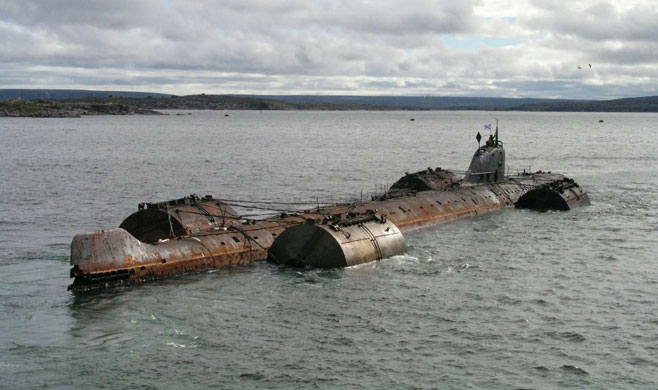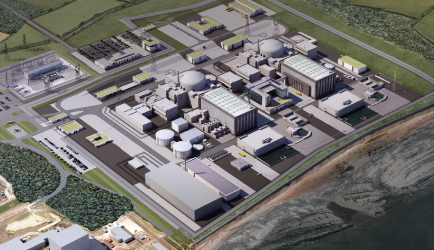
Blog
-
Geiger Readings for February 18, 2014
Ambient office = 93 nanosieverts per hourAmbient outside = 100 nanosieverts per hourSoil exposed to rain water = 86 nanosieverts per hourHeirloom tomato from Costco = 114 nanosieverts per hourTap water = 119 nanosieverts per hourFiltered water = 94 nanosieverts per hour -
Radioactive Waste Waste 116 – Russian Nuclear Disposal Sites in Barents and Kara Seas Threatens Norway
I have blogged before about the mess that the Soviet military left in the Barents and Kara Seas off their north coast. They just dumped nuclear components, reactors, ships and submarines into the Seas. Now Norway, which borders on that area of what used to be the Soviet Union are worried about this toxic nuclear legacy.
The Soviet Union used the Barents and Kara Seas as nuclear dumping ground for its nuclear waste for decades. Russia continued the practice after the Soviet Union dissolved. The following items were disposed of in the two Seas.
19 ships that contained nuclear waste
14 ships with nuclear reactors (five still contained spent nuclear fuel)
735 pieces of heavy machinery that were radioactively contaminated
17,000 containers filled with radioactive waste
3 nuclear submarines with nuclear fuel in their reactors
The most dangerous of these are the submarines.
K-27 is the designation for an experimental nuclear sub launched in 1962. Its reactor started leaking radiation during a mission in 1968. Nine crewman were killed by the radiation and the rest of the crew suffered serious illnesses. In 1981, the K-27 was sunk in about a hundred feet of water, far shallower than the international rules for such disposal. The K-27 submarine could leak massive amounts of nuclear contamination into the Seas if the casings on its reactors fail.
The K-159 submarine was commissioned in 1963. Its entire propulsion system was contaminated with radiation after a coolant leak. They kept repairing it until it was taken out of service 1989. By 2003, its hull was so badly rusted that pontoons had to welded to the sub to keep it from sinking. IN 2003, they tried to sail it to a disposal site but during a storm, one of the pontoons broke away and it sank just sixty miles from the Norwegian border. This wreck contains seventeen hundred pounds of nuclear fuel and poses the greatest threat to Norway.
The Bellona Foundation, an international environmental NGO based in Oslo, Norway, has been lobbying for action on dealing with this nuclear waste from Russia since the Soviet Union collapsed in the early 1990s. They issued an important report in 1994 with the title “Sources of Radioactive Contamination in Murmansk and Archangel Counties” to alert the world to the dangers posed by decommissioned Soviet nuclear submarines.
The Chief Executive of the Bellona Foundation said in a recent interview with the Dagbladet newspaper that the wreckage of the old ships and submarines could start leaking radioactive waste into the Seas within the next ten to fifteen years. This could impact important industries like fishing off the north coast of Norway.
One complication in making progress in this situation is the fact that relations between Russia and Western Europe have recently soured over the Russian annexation of the Crimea and support for rebel factions in eastern Ukraine. Last December, Russia cancelled the Cooperative Threat Reduction Program which it had signed with the United States Department of Defense in order to prevent the leakage of radiation from their undersea nuclear waste dump.
All the major nuclear power have followed the same practice of totally ignoring environmental concerns while developing their nuclear weapons. In the U.S., decades after the end of weapons production, the Hanford Nuclear Reservation is still one of the most radioactively contaminated places on the planet. The British are still trying to clean up Sellafield. The legacy of the Cold War arms race lives on and threatens lives.
K-159 Russian nuclear submarine:
-
Geiger Readings for February 17, 2014
Ambient office = 88 nanosieverts per hourAmbient outside = 80 nanosieverts per hourSoil exposed to rain water = 69 nanosieverts per hourAvacado from Costco = 74 nanosieverts per hourTap water = 91 nanosieverts per hourFiltered water = 85 nanosieverts per hour -
Nuclear Reactors 212 – Austria and the United Kingdom Are Fighting About New U.K. Reactor.
I have blogged about the new nuclear reactor that the British intend to build at their Hinkley Point power plant. I just recently blogged about Austria’s campaign to end the use of nuclear power in the European Union. Today, these two subjects collide.
The thirty billion dollar U.K. Hinkley Point project to build a new nuclear power reactor is expected to begin generating its more than three gigawatts of power in the early 2020s. If the project goes as planned, the new reactor will be able to replace the lost generating capacity from the retirement of currently operating power plants. Britain claims that it needs the new reactor to insure that the U.K. does not experience blackouts from lack of electricity in the future.
Although nuclear power is a low-carbon source of energy which fits with the U.K. climate change mitigation plans, it is also much more expensive than fossil fuel power plants. In order to build the new reactor, the U.K. is going to allow EDF, the operators of the new reactor, to charge twice as much as the current going rate for electricity without which the new reactor could not compete in the energy market. Critics say that the whole project lacks transparency and places most of the risk for the new reactor on the back of the ratepayers.
Austria has attacked Britain for offering subsidies to build the reactor. They say that the British are violating E.U. rules with respect to subsidies. Austria has appealed to the European Union headquarters in Brussels to stop the British plan. Austria is not against low-carbon energy subsidies in the E.U. but they want those subsidies to go to renewable sources like solar, wind and hydr.
Not surprisingly, the British are furious at what they consider to be interference from Austria. The Prime Minister has threatened to take “every opportunity to sue or damage Austria” unless Austria backs off. Austria replied that they are not going to be intimidated by British threats. Saying that you are going to “damage” another country in the E.U. does seem a bit extreme.
Apparently Austria’s objections have borne fruit. EDF, the French utility that is going to construct and operate the new reactor for the British, is going to delay its final investment decision with respect the new Hinkley Point reactor until the question of British governmental support is resolved. The longer the delay, the greater the cost is going to be. Austria may hope to kill the project by making it too costly.
The E.U. is in the process of developing an “Energy Union” for member countries. They intend to present the plan later this month. This dispute over nuclear power subsides on the part of two E.U. members is threatening to undermine efforts for a common energy policy in the E.U. Analysts say that questions about nuclear subsidies are a fundamental issue if they distort the economics of the E.U. energy market. The E.U. will have to balance competitiveness, climate change mitigation, renewables and energy security in any “Energy Union.” It will not be easy and may prove impossible.
Artist’s concept of Hinkley Point C reactor:
-
Geiger Readings for February 16, 2014
Ambient office = 71 nanosieverts per hourAmbient outside = 91 nanosieverts per hourSoil exposed to rain water = 101 nanosieverts per hourBanana from QFC = 78 nanosieverts per hourTap water = 97 nanosieverts per hourFiltered water = 92 nanosieverts per hour -
Radiation News Roundup February 15, 2014
China urges Iran to uphold its right to ‘peaceful use of nuclear power.’ Rt.com
Sri Lankan president signs nuclear deal with Indian PM. Aljazeera.com
U.S. power companies struggling with the escalating costs of building nuclear plants are closely watching similar efforts in China, where officials are expecting delays. Carlotteobserver.com
The head of the Leningrad Phase II nuclear power plant construction project in western Russia has said commissioning of all four of the planned units may be delayed by a year. World-nuclear-news.org
-
Geiger Readings for February 15, 2014
Ambient office = 102 nanosieverts per hourAmbient outside = 159 nanosieverts per hourSoil exposed to rain water = 149 nanosieverts per hourAlmonds from Costco = 79 nanosieverts per hourTap water = 91 nanosieverts per hourFiltered water = 79 nanosieverts per hour -
Geiger Readings for February 14, 2014
Ambient office = 103 nanosieverts per hourAmbient outside = 90 nanosieverts per hourSoil exposed to rain water = 90 nanosieverts per hourBlueberries from Costco = 98 nanosieverts per hourTap water = 81 nanosieverts per hourFiltered water = 76 nanosieverts per hourDover sole – Caught in USA =86 nanosieverts per hour






